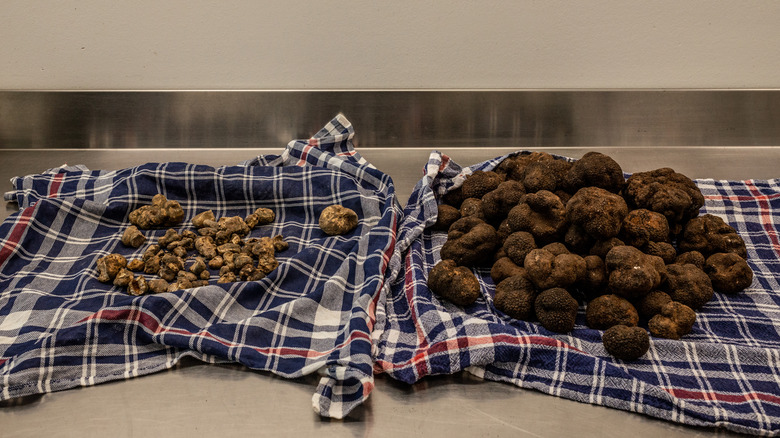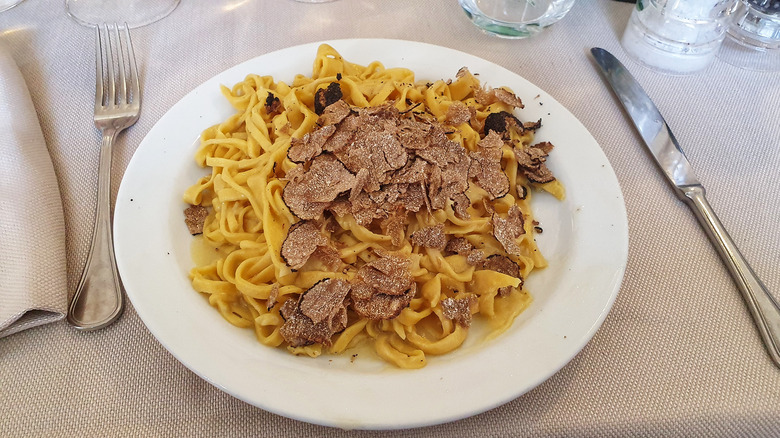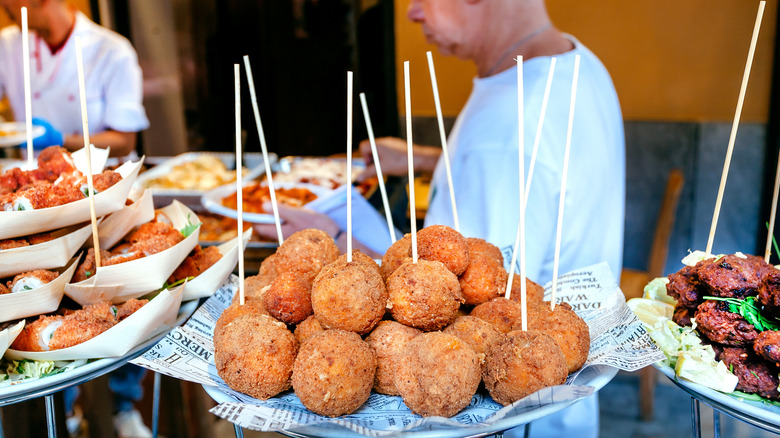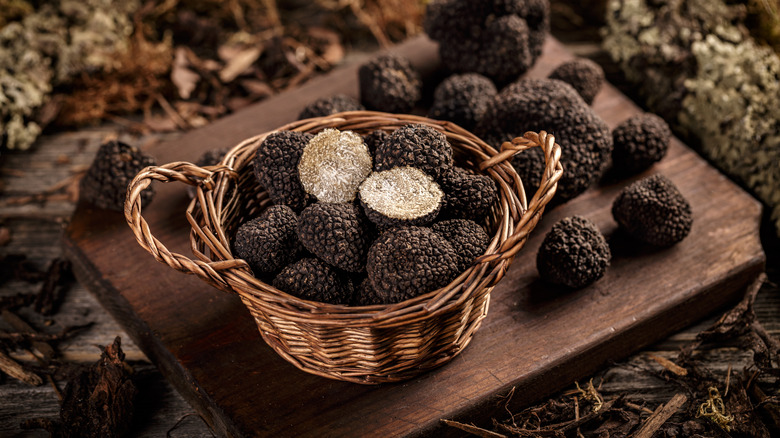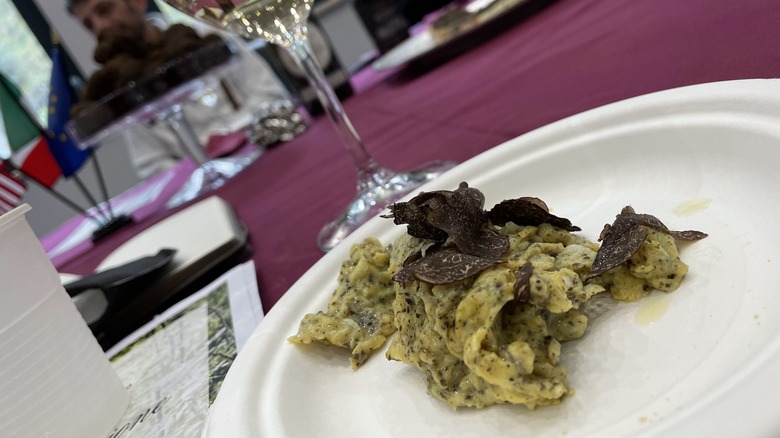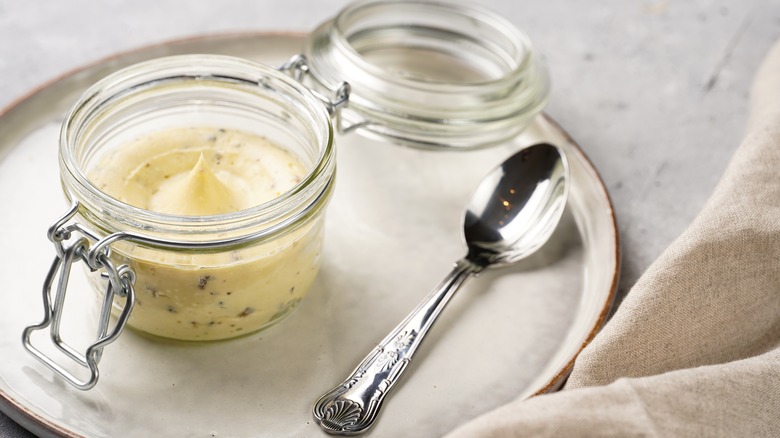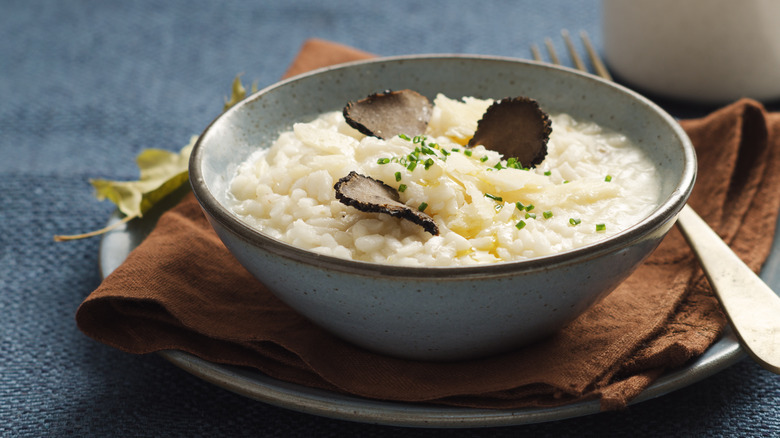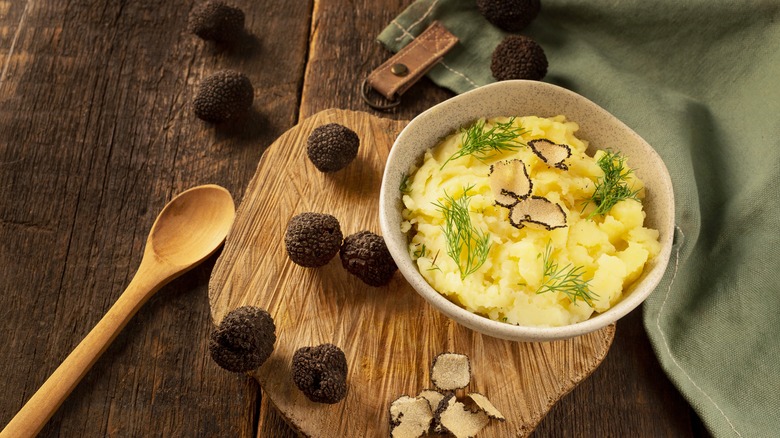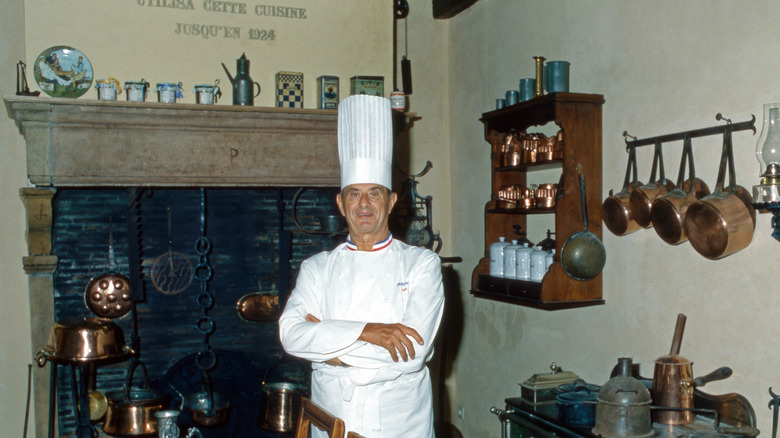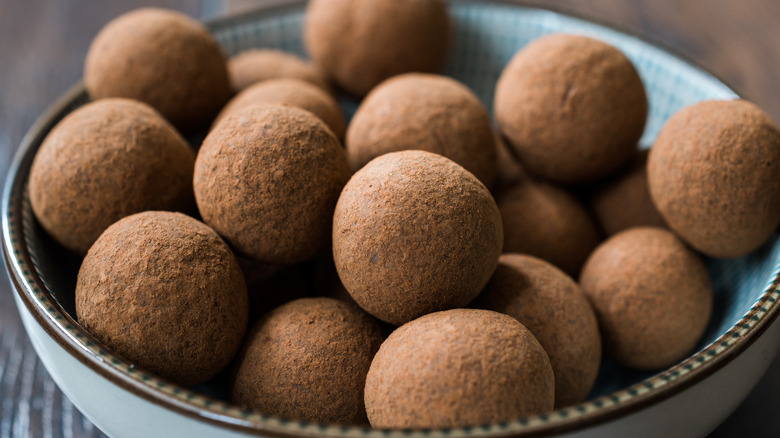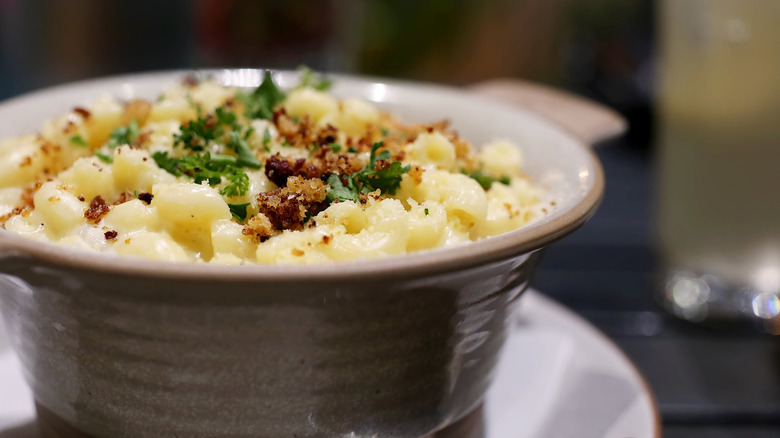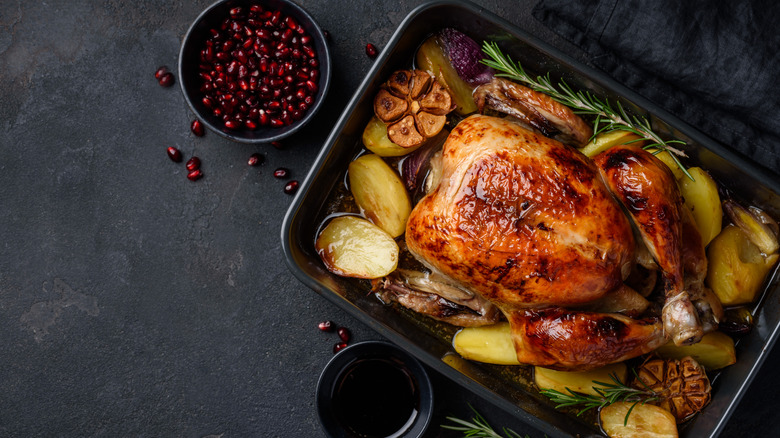11 Best Ways To Use Truffles
Wild truffles are found around the world, but only the most precious culinary truffles are regarded as one of the finest ingredients. These delicacies originate mainly in Europe, the Pacific Northwest region of the United States, and Australia. If you've ever seen or smelled a truffle, it's likely to have made an impression. For many chefs, there are recipes for which only a truffle will do, thanks to the unmistakable, earthy, heady profile they offer. "The unique flavor of truffles is one of the main reasons [they] get worldwide attraction as a food product," according to the researchers behind a study in Molecules journal.
Materials from the Oregon Truffle Festival, held annually in Eugene, explain that "truffles are the 'fruit' of fungi that grow on the roots of host trees in a symbiotic relationship." Skilled hunters — primarily dogs, but historically also pigs — sniff out the location of truffles because they are often not visible and hidden under the soil. They are seasonal, rare, and require a certain amount of handling and storage to be elevated in a culinary setting. For these reasons, truffles are highly valuable, worth hundreds or even thousands of dollars per pound, depending on the species, quality, size, and the sales setting. The most treasured truffles from Europe are the Périgord black truffle, Italian white truffle, summer or Burgundy truffle, and bianchetto truffle. The truffle vibe may be intimidating to home cooks, but it doesn't need to be. Here are the best ways to use truffles.
Grate truffles over pasta
For many people, fresh pasta with thinly sliced or grated truffles is the ideal way to enjoy this delicacy. Many chefs say that this simple prep method best shows off the truffle qualities. "When using truffle in recipes, you'll want to avoid cooking your truffle too much as it will drive off the flavor and aroma," executive Chef Kim Brennan of State Buildings located in Perth, Western Australia told us. "Slicing or grating truffles just before serving is the best way to retain flavor."
Any pasta is fair game, though often it's served with long, strand-like varieties, such as tagliatelle or the eggless ciriole pasta from Umbria in central Italy. Depending on preference and type, truffles can be grated directly onto the pasta or into some warm butter, perhaps with a bit of grated cheese, garlic, or pepper. The general sense of this dish is to use the best ingredients possible, keep it simple, and let the flavors do the work.
Add flavor to arancini with truffle
Arancini are a Sicilian snack classic. To make them, start with cooked rice, and add savory ingredients based on preferences or availability. When the balls are assembled, they are coated in breadcrumbs and fried. While the original staple is simple — arborio rice and mozzarella cheese, with the option to add meat or veggies — many chefs have upgraded arancini to reflect various cuisines or cooking styles, including Spanish, French, Chinese, and Japanese flavors.
To include truffles in this dish, add finely chopped bits to the rice before breading. It's also possible to shift the cheese style or type from mozzarella to something with differently dynamic flavors. A range of bold or mild cheeses would work, from aged cheddar to goat cheese or whatever the local cheesemonger recommends. A carbonara arancini version uses Parmigiano Reggiano, which would be a delicious addition to maintain Italian traditions. Look for cheese with adequate melting potential, so the arancini deliver plenty of hot gooey-ness when served.
Make truffle cream
DJ MacIntyre is the executive winery chef at Domaine Willamette and Willamette Valley Vineyards. He told Tasting Table that the aromatics of Oregon truffles can be captured in ingredients that contain fats and oils. "I like to place paper milk cartons full of whipped cream, pounds of butter, and eggs into a large plastic tote with the truffles in it for a couple of days," he says. (This all goes in the refrigerator). According to Chef MacIntyre, "I have a couple of gallons of cream (still in the paper aspic container) that now tastes like truffle." There is another method for making truffle cream if you don't have the time to let the aromatics infuse over the course of a few days. Mince ⅓ ounce of black truffle into 3 cups of heavy cream. This should be covered and kept chilled for several hours.
Some truffles are more aromatically potent than others, so choose appropriately. "It has been reported that the black truffles have the highest aromatic rate while summer truffles have the lowest, and white truffles are in between," according to a 2020 study published in Molecules journal. "As truffles are a perishable commodity with a short shelf life (about one week), storage temperature and time are major factors influencing truffle aroma."
Add them to scrambled eggs
One of the most common and simple meals is elevated with the heady flavors of truffles, according to Chef Kim Brennan. It's all about eggs, one of the easiest ways to fill the kitchen with truffle magic in a few minutes. "Truffle works well with egg pasta and on top of any style of eggs, whether it be poached or scrambled," he told Tasting Table. "I enjoy grating truffle on top of perfectly cooked eggs, or on top of a fresh egg pasta with a butter and parmesan sauce."
One of the secrets of success when it comes to scrambled eggs is adequate seasoning. Truffles take the flavoring process up a notch. Add minced truffles during the sauté state, or add thinly sliced truffles atop fluffy scrambled eggs. Or go for both, as recommended by Valnerina Tartufi Umbria during our recent visit to its facility in Umbria. Though it might be unexpected to pair eggs and wine, truffle-topped scrambled eggs and a chilled glass of Trebbiano Spoletino — such as the release from Agricola Spacchetti — is a delightful matchup.
Make your own truffle butter
As Chef MacIntyre described above, truffles can transform the profile of other ingredients while they are stored briefly in the refrigerator. As truffles are best consumed soon after harvesting, the short period that they grace the kitchen can be maximized by capturing their aromatics in other cuisine staples. "The truffle aroma is fat-soluble and will accumulate in any fatty substance in the vicinity," according to documentation from the Oregon Truffle Festival. "The aroma will penetrate eggshells, the wrapping around sticks of butter, or a wax paper wrapping around cheeses, cured meats, and nuts."
The addition of truffle is a truly easy way to turn store-bought butter into a gourmet experience. If home-making butter, it's possible to add minced truffle for a more pungent taste. Either way, truffle butter can be melted on steaks hot from the grill, baked potatoes, mashed potatoes, or any other dish that needs a savory, buttery kick.
Add umami to risotto with truffles
At Tasting Table, we start with a basic risotto plan that can be developed by additional flavors. We kick off risotto prep night by toasting short-grained rice with sautéed onions. This rice is slow-cooked with the gradual addition of stock and white wine. "Risotto doesn't need anything but a good stir to make it shine, but if you want to get creative, it's the perfect blank canvas for mix-ins," according to our primer on making creamy risotto at home. Truffles can be shaved thinly and served on top of a piping hot bowl of risotto, or they can be minced and blended in as seasoning just before the dish is finished.
But don't plan on infusing rice in a way similar to what's been suggested for butter or cream. This won't work, notes the experts at Eatily. The rice will in fact dry out the truffles, which will diminish their quality and aromatics.
Make your mashed potatoes with them
Though this dish might be called the king of comfort foods, there is no right way to make mashed potatoes. Forked, riced, mixed, or otherwise brought to the perfect creamy consistency, mashed potatoes are a delicious canvas to include savory ingredients, especially loads of butter. For rich truffle flavors, you could add homemade truffle butter describe above, or get more creative, as Chef DJ MacIntyre described to us.
He starts by infusing hazelnuts with truffles (in the fridge technique described above). "I then dry roast the hazelnuts, puree them with the infused cream and butter, and use that to make truffled-hazelnut mashed potatoes," he says. But the layers of flavor don't stop there. On top of the whole thing, he micro-planes more Oregon White Truffles on top. When it comes to layering truffle flavors in this way, he describes the result as all-encompassing. "It is like buying a grafted apple tree — one plant, but you get four to five different varieties of apples from each branch," says Chef MacIntyre.
Add truffle to soup
There is a world-famous truffle soup created by the legendary French Chef Paul Bocuse. In 1975, it was served at the Élysée Palace in Paris in dedication to the former French President Valéry Giscard d'Estaing, (via Falstaff). It's often referred to as truffle soup VGE, a decadent dish made with ingredients such as vermouth, foie gras, black truffles, vegetables, and chicken breast. It is served to diners in individual tureens and capped with a golden puff pastry top. This is truffle soup at its extreme.
Including truffles in a soup can be much easier. Try making homemade mushroom soup and layering the earthy notes by shaving white truffle on the top just before serving. You could also add some minced truffle to mushroom and barley soup, to give this deli classic a rich vibe. For a truly flavor-packed bowl, try adding micro-planed truffles over savory garlic soup — the kitchen will be highly aromatic!
Add them to desserts
One of the most confusing things about truffles is that there are two different cuisine elements that share this same name: the product of fungi and the little round chocolate treat. To add another layer of head-scratching, the fungi can actually be incorporated into a variety of sweet dishes, including the ultimate surprise of truffle ice cream. In terms of selection, Chef MacIntyre says that black truffles are most commonly used in desserts, including creamy and chocolate-laden plates. "Oregon Black Truffles have a sweeter flavor when compared to the Oregon Whites, which are very pungent, earthy, almost garlicky," he says.
Chef Kim Brennan told us that dairy-based desserts are one of the "biggest secrets in successful truffle cooking," because the lactic acid in dairy breaks down, unlocking more of the truffle's rich flavors. "We've used truffle to make a truffle ice cream where the ice cream base is infused with vanilla and freshly grated truffle," says Chef Brennan. "The result is a fragrant, creamy, and rich ice cream that's perfect on its own or with a hot steamed pudding."
Dress up macaroni and cheese with truffles
The flavors of truffles are harmonious with creamy, rich dishes, and there's no better playground for this profile than homemade macaroni and cheese. Any type of pasta and cheese will do, such as white cheddar and cavatappi, or campanelle and gruyere. Look for any type of pasta that has an ample area to hold sauce, either hollow inside or with folds and texture for the cheese to grip onto. Top it all with toasted breadcrumbs, and you've got a crowd-pleasing meal that can be just as delicious served as leftovers.
There are plenty of ways to dress up this dish so that it doesn't have a school cafeteria vibe. One of the most decadent is with a shaving of fresh truffles across the top. Watch out for recipes that instruct the use of truffle oil. This is safe and tasty to incorporate, but most commercial truffle oils actually don't contain truffles. Instead, they use synthetic ingredients. It is possible to get authentic truffle oil from purveyors in places such as Burgundy and Umbria, but it's quite rare and more common to find truffle-flavored oil.
Roast poultry with truffles
While roasted chicken is a Sunday lunch staple, and, of course, that golden turkey is the symbol of some of the tastiest holiday traditions in the United States, perhaps it's time to try something a bit different. Consider adding truffles to oven-roasted poultry to supply a savory, earthy layer to the already-delicious flavors of these birds. One of the easiest and most economical ways to add truffle flair to poultry is by utilizing a few pats of homemade truffle butter, described above.
The truffle butter should be at room temperature so that it easily spreads. Start around the neck and loosen the skin of the chicken or turkey with your fingers. Spread the truffle butter along the meat, working back along the breast. The butter will be visible under the skin, allowing for adequate and equal coverage. As the turkey or chicken cooks, the butter will melt and infuse the meat with truffle butter flavor. Butter under the poultry skin keeps the bird tender and juicy, a crowd-pleasing meal for special holidays or family time around the table.
